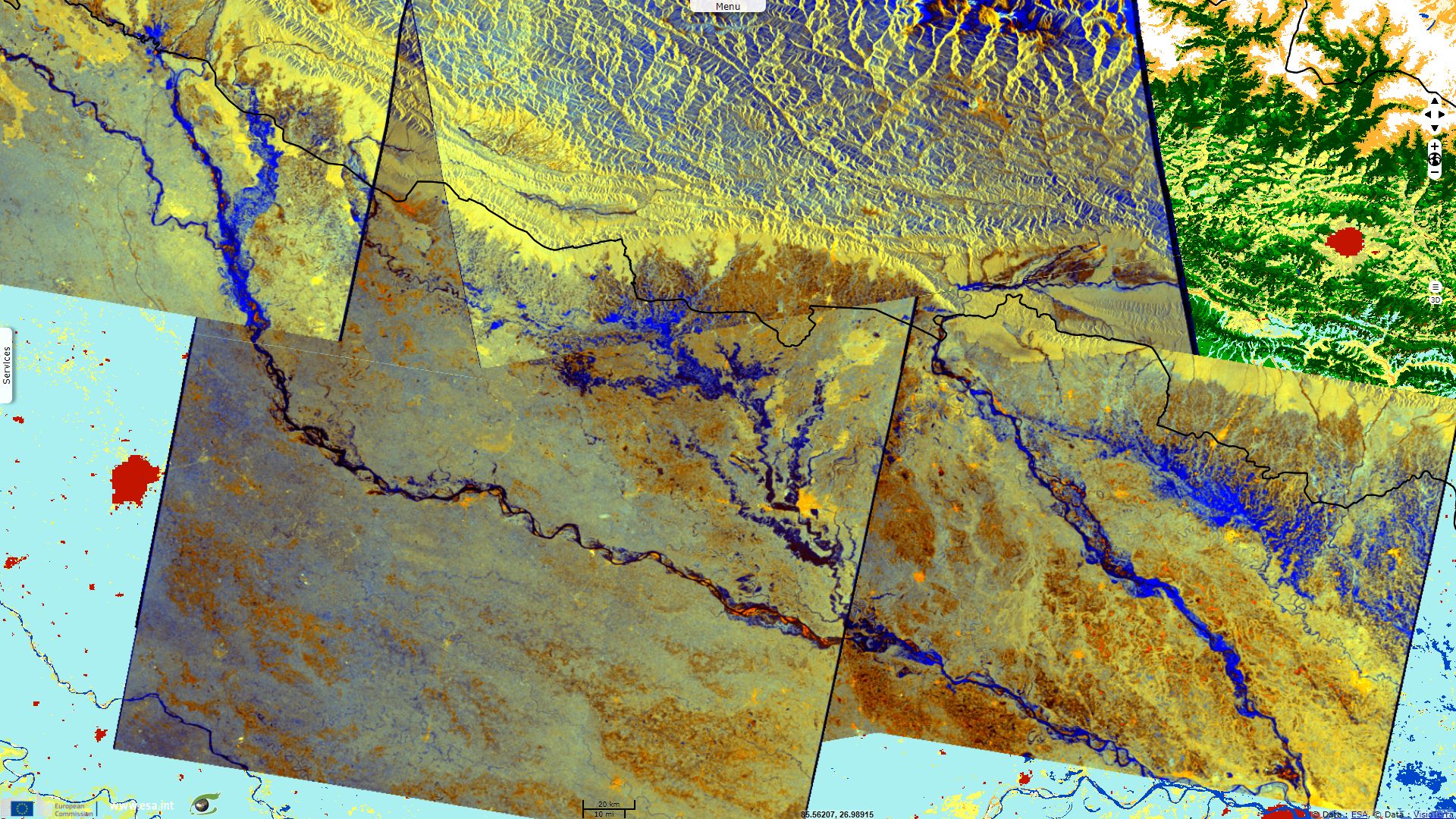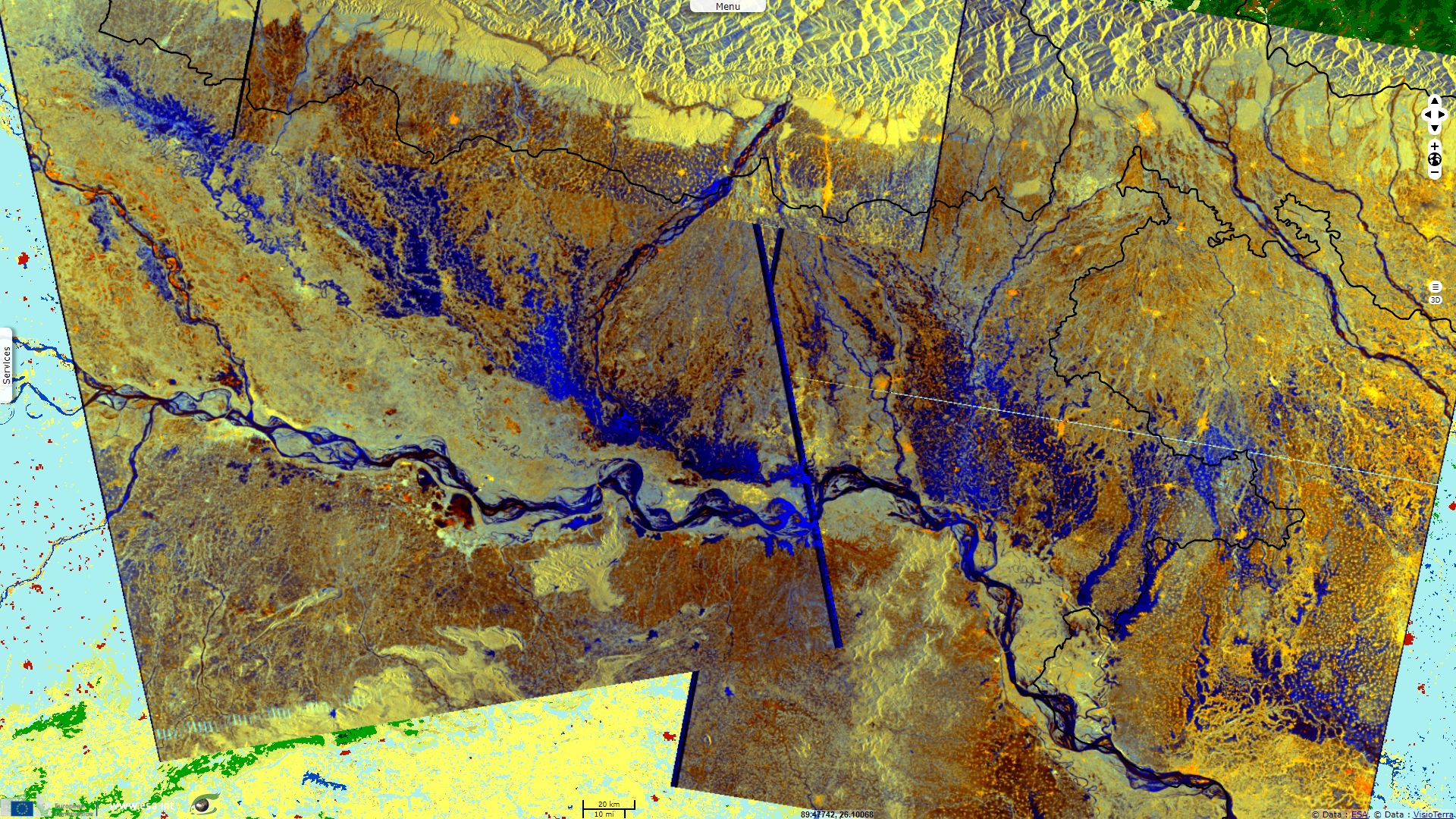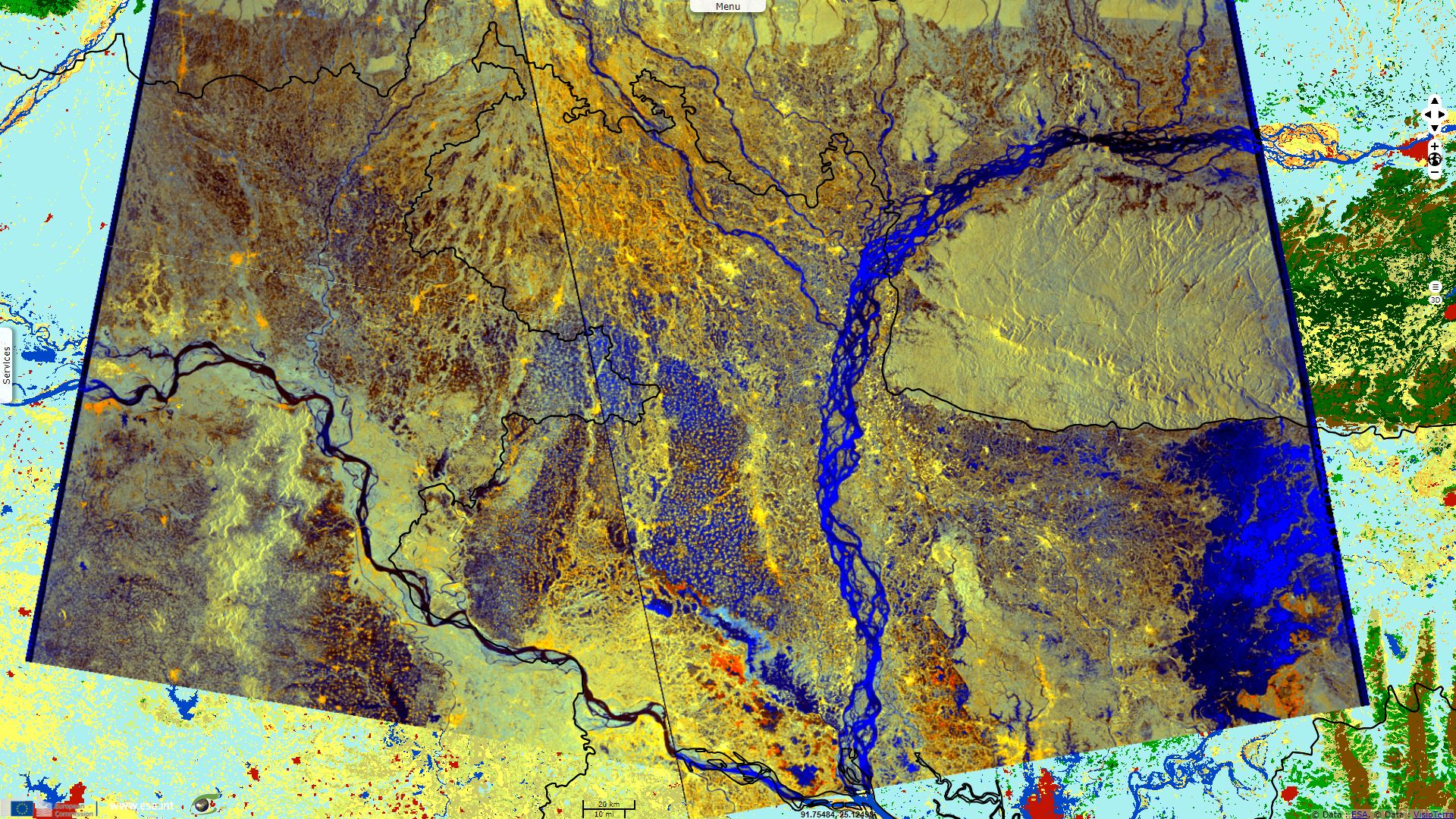Heavy monsoon rains in the Indian subcontinent
Sentinel-1 CSAR IW acquired on 27 May 2017 at 11:40:43 UTC
...
Sentinel-1 CSAR IW acquired on 07 July 2017 from 11:48:33 to 11:48:58 UTC
Sentinel-1 CSAR IW acquired on 22 August 2017 from 12:04:09 to 12:04:34 UTC
...
Sentinel-1 CSAR IW acquired on 07 July 2017 from 11:48:33 to 11:48:58 UTC
Sentinel-1 CSAR IW acquired on 22 August 2017 from 12:04:09 to 12:04:34 UTC
Keyword(s): Land, natural disaster monitoring, emergency, climate change, hydrology, topography, orographic precipitations, monsoon rainfalls, flooding, water management, dams, agriculture, population density, poverty, Himalaya, Bay of Bengal, Arabian sea, India, Nepal, Bangladesh
The Indo-Gangetic plain is a chevron-shaped 2.5 million km² fertile plain encompassing east of Pakistan, north and east of India and almost all Bangladesh. It is bound by Himalayas at north from which are born the Indus river that flows into the Arabian Sea at west, the Ganges and Brahmaputra rivers which both flow into the Bay of Bengal at east. This floodplain is irrigated by snowmelt but mostly from the depressions blocked by the Himalays that produce rainfalls, ripping fertile alluvium that are deposited during floods. This flat plain is rich in groundwater and allows easy irrigation, the climate is warm, making it ideal for growing crops such as rice and wheat. These cropland sustain a population exceeding 400 millions, making it one of the world's most densely populated areas.
However, the lack of infrastructures, their failures and inappropriate organisation in this region make the yearly monsoon deadly. On average, 2000 people are killed each year of its consequences, hundreds of thousands become homeless while tens of millions are otherwise affected.
UN OCHA (United Nations Office for the Coordination of Humanitarian Affairs) describes the situation: "Since the beginning of August severe monsoon rains have caused widespread flooding across South Asia". "The floods have damaged and destroyed homes, schools, health facilities and many people are currently living in relief camps and temporary shelters. People are in urgent need of food, clean water and sanitation, and shelter. There is also an urgent need for health services to prevent the spread of waterborne diseases." "The floods have destroyed crops, killed livestock and washed away people’s means of making an income. This will have an impact on communities’ immediate food security, and may also exacerbate pre-existing vulnerabilities as people are left without possessions or the means to make a living."
North-East India was hit a first time in July and later in mid August, which was the "Worst flood in 29 years" in Assam according to the Times of India.
Al Jazeera also considered the aftermath on wildlife "The heavy rain has also taken a toll on wildlife, with rescue teams pulling stranded animals from raging waters in India's Kaziranga National Park, including rare one-horned rhinos and other endangered species.". They added: "The park, a UNESCO world heritage site, is home to the largest concentration of one-horned rhinos in the world. About 15 rare rhinos, 185 deer, and at least one Royal Bengal tiger have died in the devastating floods that submerged almost the entire Kaziranga National Park in Assam state, the park's director said on Saturday. The park lost 105 animals to floods in July. That takes the total number of animals killed so far this monsoon season to 335", Satyendra Singh said.
The New-York Times comments: "Every year in South Asia, from June to September, the monsoon rains thunder down. July is often the worst month, but this year it wasn’t so bad. The rainfall had been so light, actually, that government officials said they were even thinking of starting irrigation pumps.". But around the 11th August 2017, massive monsoon rains hit Nepal, India and Bangladesh.
Kathmandu Post reports
"According to meteorologist Barun Paudel, heavy rainfall was supported by three factors: movement of the low pressure line, also called monsoon trough, closer to Nepal; presence of a low pressure system over the Chure and mid-Hills; and the entry of moisture from the Bay of Bengal and the Arabian Sea." "Shifting of monsoon trough closer and away from Nepal is a common phenomenon. However, this time it extended from East to West, which caused heavy rains throughout the country." "Rajendra Sharma, a senior divisional hydrologist at the Flood Forecasting Section of the Department of Hydrology and Meteorology (DoHM), said that cloudburst, a phenomenon of extreme rainfall within a short period of time, has been observed in the past as well."
Regarding consequences, "Senior scientist at the International Rice Research Institute Nepal Bhola Man Singh Basnet said this flood would hit paddy production this year": "As most of the districts with the highest rate of paddy production have been hit hard, paddy output will go down". "Nepal’s flooded areas are the poorest parts of the country, where most families live in bare mud houses and rely on subsistence farming, he said. Those farms are now underwater, and thousands of people are stuck living under plastic tarps in camps for displaced people where disease is beginning to spread." told Francis Markus, a spokesman for the IFRC to the New-York Times.
Concerning India, UN OCHA sums up: "In Assam, Odisha, Bihar, Uttar Pradesh and West Bengal states, flooding has affected 30 million people since the start of the crisis. At the height of the emergency, 1.1 million people were hosted in 3,271 camps.". At least 943 Indian people died.
Bihar is among the most affected states in India by the mid August monsoon floods. The flood management information system of Bihar state warns "Bihar is India’s most flood-prone State, with 76% of the population, in the north Bihar living under the recurring threat of flood devastation." About 73% of its surface is flood affected, it explains: "The plains of Bihar, adjoining Nepal, are drained by a number of rivers that have their catchments in the steep and geologically nascent Himalayas. Kosi, Gandak,Burhi Gandak, Bagmati, Kamla Balan, Mahananda and Adhwara Group of rivers originates in Nepal, carry high discharge and very high sediment load and drops it down in the plains of Bihar. About 65% of catchments area of these rivers falls in Nepal/Tibet and only 35% of catchments area lies in Bihar. A review by Kale (1997) indicated that the plains of north Bihar have recorded the highest number of floods during the last 30 years."
According to UN OCHA: "This is the fourth time Bangladesh has been affected by floods this year, and the repetitive disasters have weakened communities’ coping mechanism". The New-York Times reminds "A low-lying and densely populated country of 165 million, Bangladesh is chronically ravaged by flooding." "in what is considered one of the worst floods the country has experienced." added the IFRC. "More than 8.1 million people in Bangladesh" have been affected, 144 died and "over 697,000 houses have been damaged or destroyed."
New Delhi TV contextualize: "For the third year in a row, the monsoon season has produced floods in the northwest and the northeast, while south India has suffered from a rainfall deficit. Rainfall extremes have increased threefold over the last few years and now extend over all of central India -- from Gujarat to Odisha.".
For the case of West Bengal flooding, the DVC (Damodar Valley Corporation), a public hydropower company, has been pointed out by Chief Minister Mamata Banerjee, who said "that although there had been rain the situation had been aggravated by disproportionate release of water by DVC which had inundated 4220 km². The flood woes in Gangetic Bengal is increasingly becoming a “man-made” phenomenon", as reported by the Indian newspaper Financial Express.
As reported by Al Jazeera: "'This is the worst flooding that parts of South Asia have seen in decades.' said Jagan Chapagain, Red Cross undersecretary-general, as he confirmed the death toll given by regional authorities." while Francis Markus, a spokesman for the International Federation of Red Cross and Red Crescent Societies (IFRC) said The New-York Times: "This is the severest flooding in a number of years". UNICEF numbers: "Since mid-August, there have been at least 1,288 reported deaths, with over 45 million people estimated to be affected." Interviewed by the BBC, "Martin Faller, IFRC's (International Federation of Red Cross and Red Crescent Societies) deputy regional director, said more than a third of Bangladesh and Nepal were flooded: 'Millions of people across Nepal, Bangladesh and India face severe food shortages and disease caused by polluted flood waters.'"


Number of people affected by the mid-August flood - source UN OCHA.
While monsoon rainfalls are expected to strengthen due to climate change, good decisions may still reduce the human and economic toll as reported by The New-York Times: "Weather models predict that over the next 30 years India will experience more extreme rainfall. Asit K. Biswas, an environmental scientist and co-founder of the Third World Centre for Water Management in Mexico, said that India desperately needed better drainage systems. And he criticized politicians who complain about climate change without doing anything to help. 'It then becomes an ‘act of God,’ and thus they are not responsible,' he said. 'Sadly, South Asia’s water and flood problems are man-made, due to poor planning and management.'"










